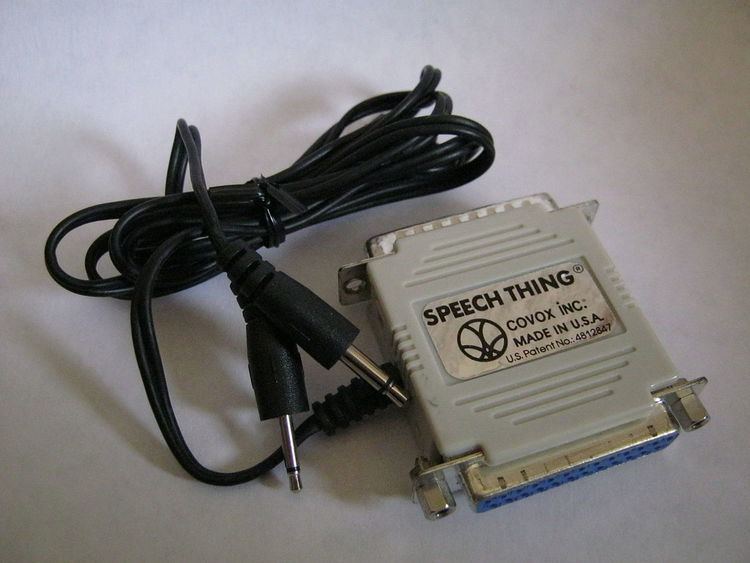Invented by Covox, Inc Common manufacturers Covox, Disney, others | Connects to Printer port | |
 | ||
Date invented 1986; 31 years ago (1986) Use audio device attached to the computer | ||
The Covox Speech Thing is an external audio device attached to the computer to output digital sound. It was composed of the most primitive 8-bit DAC using a resistor ladder and an analogue signal output, and plugged into the printer port of the PC.
Contents
The circuit was marketed around 1986 by Covox, Inc of Eugene, Oregon, for about 70 USD (79.95 USD as of 1989), but as its parts were much cheaper than the complete plug, and as its design was fairly simple, people soon started to build their own variants. The plug was used long into the 1990s, as sound cards were still very expensive at that time. The plug was also quite popular in the demoscene.
An inherent problem of the design is that it requires very precise resistors. If normal parts are used, the values get shuffled, especially for quiet sounds, resulting in distortion. Nevertheless, the sound quality of the Covox plug is far superior compared to the PC speaker; even today, a self-built Covox plug is still an inexpensive way to give old computers sound capabilities.
Commercial products
Features
In its simplest form, Covox received 8-bit, mono signal through the parallel port and produced analog output that could be amplified and played back on loudspeakers. Sampling rate was not fixed by hardware means, and theoretically Covox can support any sampling rate. In practice, however, parallel port speed limits make it rather hard to achieve even standard CD-quality 44100 Hz. Another limiting factor compared to real sound cards was the need to use the computationally demanding timer interrupt to play background music, since there was no direct memory access available.
Advanced versions of Covox-like devices featured:
Games
The Covox plug couldn't directly substitute any of the popular cards of that age (AdLib, Sound Blaster, Gravis Ultrasound, etc.), but several games / platforms supported it directly. Notable entries include:
Music trackers
Popular DOS-based trackers used on demoscene included Covox support, for example:
Emulators
Emulators existed that allowed Covox to act as if there was another soundboard installed:
In reverse, the DOSBox and Fake86 emulators allow to emulate presence of Covox (as Disney Sound Source) on a machine without such physical device connected.
As of 2015 the circuit for the Disney Sound Source has been reverse engineered, so Covox plugs can be used with software requiring such hardware without the need of any additional software emulators using an additional plug that goes between the computer's LPT port and the Covox.
Operating Systems
Several operating systems have a driver for Covox available for install:
